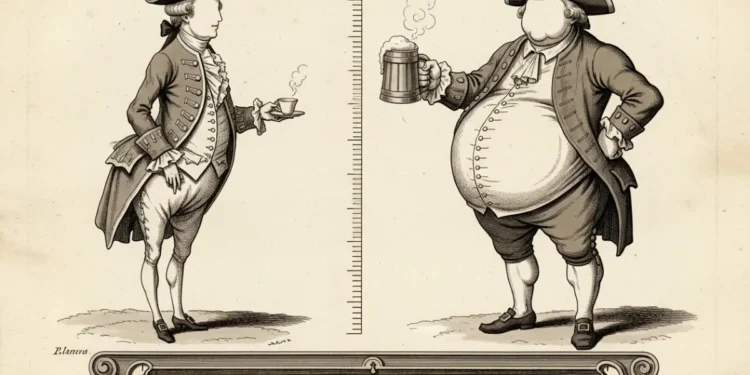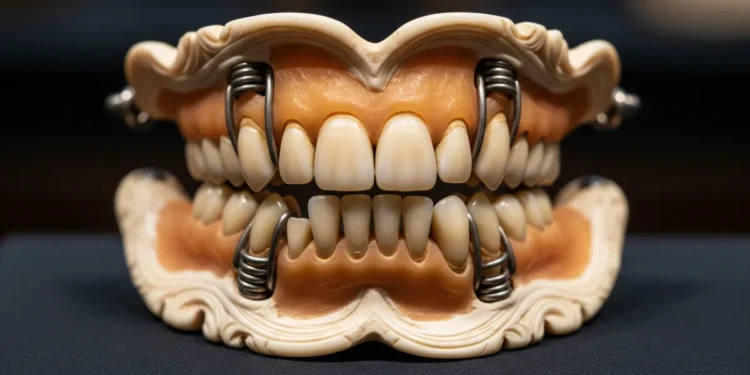A focused historical analysis of the Napoleon Height Myth, showing how propaganda, measurement differences, and caricature culture produced a durable false impression.
Table of Contents
Introduction
The Napoleon Height Myth is arguably one of the most successful and enduring pieces of character assassination in modern history. The image of a diminutive, hand-in-waistcoat tyrant, seething with rage and ambition, is so deeply embedded in our cultural consciousness that it feels like an undisputed fact. Yet, it is a complete fabrication, a masterpiece of political propaganda born from the bitter rivalry between France and Britain. This was never a simple misunderstanding about a ruler’s stature; it was a deliberate campaign to diminish a formidable enemy, to shrink his military genius and political power down to a laughable, manageable size. Rethinking the Napoleon Height Myth is to uncover a lesson in how easily a lie can become history.
This article dismantles the myth, piece by deliberate piece, to reveal the political machinery behind it. We will begin by exposing its origin: a simple, almost comical, error in converting French pouces to British inches, a mistake that was too politically convenient to ever be corrected. From there, we will delve into the vicious world of British caricature, where artists like James Gillray used their ink to wage a visual war, creating the iconic “Little Boney” that would define a legacy. We will also explore how even Napoleon’s affectionate nickname from his adoring troops, Le Petit Caporal, was twisted into a term of ridicule.
Furthermore, we will analyze how the emperor’s own elite Imperial Guard, composed of giants, created a constant optical illusion that made their average-height leader appear small by comparison. Finally, we will trace the myth’s journey after Napoleon’s death, showing how it solidified through historical negligence and evolved into the modern psychological term “Napoleon complex.” The consequences of the Napoleon Height Myth serve as a stark reminder that history is often shaped not by what happened but by the stories that are told, repeated, and ultimately believed.
The Inch That Became a Mile: How Measurement Confusion Sparked a Myth
At the heart of the Napoleon Height Myth lies a simple, almost mundane mistake: the failure to properly convert units of measurement. In the 18th and early 19th centuries, Europe was a patchwork of different standards. The pre-metric French system used a unit called the pouce, or “thumb,” which was longer than the British imperial inch. A French foot (pied du roi) consisted of 12 pouces but measured approximately 32.5 cm, while a British foot was only 30.48 cm. This seemingly minor difference was the seed from which a colossal historical inaccuracy would grow, providing the perfect kernel of “truth” for a myth to latch onto.
The most crucial piece of evidence comes from Napoleon’s autopsy, conducted by his physician, François Carlo Antommarchi, after his death on St. Helena in 1821. The report recorded his height as “5 pieds, 2 pouces,” which translates to 5 French feet and 2 French inches. When directly and incorrectly converted into the imperial system, this figure appears as a mere 5 feet 2 inches. This is the number that his British captors eagerly circulated, as it fit the narrative they had been carefully constructing for years. The flawed Napoleon Height Myth began not with a lie, but with a convenient mistranslation that was too politically useful to correct.
When the French measurements are converted accurately, Napoleon’s height comes out to approximately 5 feet 6.5 inches (about 1.69 meters). This was a perfectly average, even slightly above average, height for a French man of the early 19th century. The historical record is clear, yet the misinterpretation prevailed. Whether this was a deliberate act of propaganda or a simple, negligent oversight is debatable. What is certain, however, is that this conversion error provided the pseudo-scientific foundation for the entire Napoleon short myth, allowing a caricature to be presented as fact and cementing one of history’s most enduring pieces of political disinformation.
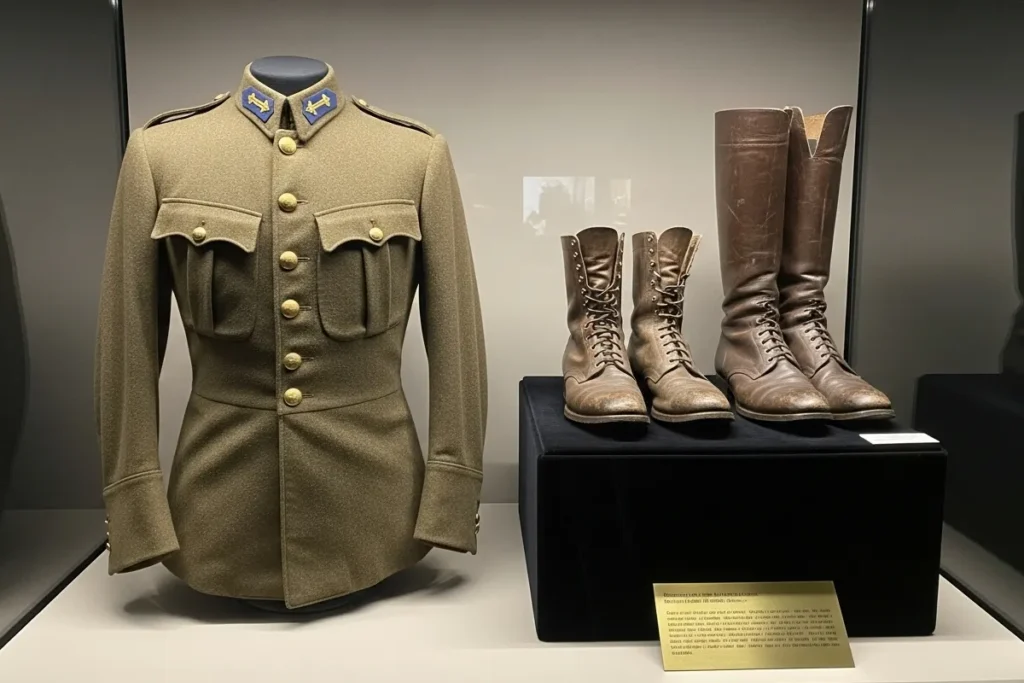
Little Boney in Ink: The Power of British Political Caricature
If measurement confusion laid the foundation for the Napoleon Height Myth, then British political satire built the house. In the late 18th and early 19th centuries, London was the epicenter of a booming caricature industry, and Napoleon was its greatest subject. Artists like James Gillray wielded their pens like weapons, systematically crafting an image of the French emperor as a diminutive, petulant tyrant. In their wildly popular prints, he was “Little Boney,” a comical figure drowning in oversized boots, throwing childish tantrums, and being physically dwarfed by British leaders. This was a deliberate strategy to strip him of his mystique and portray the formidable conqueror of Europe as a ridiculous, non-threatening man-child.
These caricatures were not confined to elite circles; they were displayed in print shop windows for all to see, becoming a primary source of news and opinion for a semi-literate public. For the average Briton who would never see the emperor in person, this satirical depiction was of Napoleon. The constant visual reinforcement created a powerful and enduring mental shorthand, cementing the link between Napoleon and smallness in the public consciousness. The caricature origins Napoleon is a masterclass in effective propaganda, where repetition and ridicule successfully overwrote reality. The image of a tiny, furious general became far more memorable than the truth.
This visual assault must be understood within the broader context of the relentless French-English propaganda wars. For years, Britain struggled to defeat Napoleon on the battlefield; however, they could decisively beat him in the court of public opinion. By infantilizing their greatest foe, the British government could simultaneously boost domestic morale, demonize the enemy, and justify the enormous human and financial cost of the war. The Napoleon short myth was not merely a joke; it was a calculated tool of psychological warfare, proving that an image, when repeated enough, could become more powerful than any fact.
A Term of Endearment, Twisted: The Real Story of “Le Petit Caporal”
Adding another layer of seeming “proof” to the Napoleon Height Myth was one of his most famous nicknames: Le Petit Caporal, or “The Little Corporal.” To his enemies, this was an open admission of his diminutive stature. But the reality behind the name tells a story not of physical size, but of leadership and affection. The nickname was bestowed upon him by his oroops after the grueling Battle of Lodi in 1796. During the battle, Napoleon, then a young general, defied military convention by personally helping to aim and position cannons alongside his artillerymen. This was a task for a low-ranking corporal, not a commander-in-chief.
His soldiers, impressed by his bravery and hands-on approach, gave him the name as a sign of respect and camaraderie. It was a term of endearment. The “Petit” in this context did not mean “short” but was an affectionate qualifier, closer in meaning to “beloved” or “our guy.” It signified that he was one of them, a leader willing to get his hands dirty and share the dangers of the common soldier. This act was central to forging the legendary loyalty of his army, who saw him not as a distant aristocrat but as a fellow soldier who earned his place through grit.
This context, however, was deliberately stripped away by British propagandists. They seized upon the literal translation of “Little Corporal” and presented it as irrefutable evidence for the physical narrative they were already promoting. The affectionate subtext was lost, or more accurately, discarded. By co-opting his own army’s term of endearment and twisting its meaning, Napoleon’s enemies performed a masterful act of psychological warfare. They turned a symbol of his strength—his connection with his men—into a pillar of the flawed Napoleon Height Myth, ensuring the slander would be tied to his very identity.
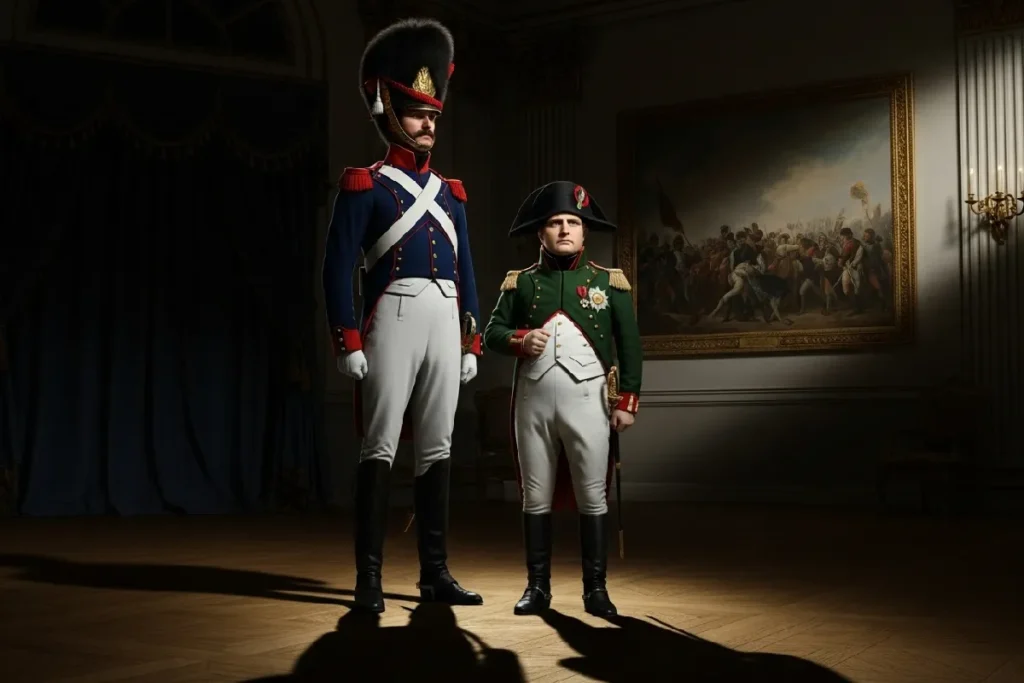
The Shadow of the Guard: Creating an Illusion of Smallness
Visual context played a crucial, and often overlooked, role in solidifying the Napoleon Height Myth. The emperor was almost always seen in the company of his elite personal bodyguards, the Imperial Guard. This was a fighting force, but it was also a key part of his public image. To be accepted into its most prestigious units, such as the Grenadiers à Pied, a soldier had to meet stringent physical criteria, including a minimum height requirement that was significantly taller than the average 19th-century Frenchman. These men were, by design, giants of their time, selected to project an image of overwhelming power and invincibility.
By surrounding himself with these imposing figures, Napoleon, a man of average height, inadvertently created a persistent optical illusion. In public appearances, parades, and even on the battlefield, he was a figure of normal stature flanked by titans. For any observer, the immediate visual takeaway was one of stark contrast. This relative difference made him appear shorter than he was, creating a misleading impression that was as powerful as any caricature. The constant presence of the Guard provided a living, breathing visual aid for the very myth his enemies were so keen to promote.
This visual “evidence” was the final, crucial piece of the puzzle. It provided seemingly irrefutable proof for those already primed by propaganda to believe in a diminutive dictator. The caricature was now seemingly confirmed by eyewitness accounts, and the historic measurement myth appeared to be validated by simple observation. It was a perfect storm of perception management, where the symbols of Napoleon’s power—his elite guard—were turned against him. They cast a literal shadow over their leader, one from which his historical image has struggled to escape, reinforcing the consequences of the Napoleon Height Myth in the public eye.
The Myth Outlives the Man: Posthumous Propaganda and Historical Negligence
Napoleon’s death in 1821 did not end the assault on his character; it merely passed the torch to a new generation of writers and historians. In the decades that followed, British and other European accounts of the Napoleonic era largely adopted the wartime propaganda as historical fact. The image of the diminutive, furious tyrant was a convenient narrative that reinforced the righteousness of the Allied cause. These early histories, often written without critically re-examining primary sources like the autopsy report, cemented the caricature into the academic record. The Napoleon Height Myth was laundered through scholarship, giving it a veneer of credibility it never deserved.
From these biased histories, the myth bled into the wider culture, becoming an unassailable “fun fact.” It appeared in school textbooks, encyclopedias, and eventually films, where the image of a comically short Napoleon became a lazy visual shorthand for any ambitious or overcompensating leader. This transition from propaganda to popular knowledge illustrates a remarkable degree of historical negligence. For over a century, few bothered to question the origins of the claim or perform the simple metric conversion that would have debunked it. The story was simply too good, and too widely accepted, to be challenged by inconvenient facts.
Rethinking the Napoleon Height Myth requires us to ask why this particular fabrication was so sticky. The answer may lie in its narrative perfection. The idea of a physically small man trying to conquer the world is a psychologically compelling archetype that speaks to themes of ambition, insecurity, and hubris. It’s a simple, memorable, and slightly moralistic tale. Later generations were willing to accept a narrative crafted by an enemy state not just out of negligence, but because the myth itself felt more satisfying than the mundane reality of an average-height man with extraordinary ambition.
From Emperor to Complex: Modern Legacies of a Historical Lie
Perhaps the most enduring legacy of the Napoleon Height Myth is its enshrinement in our psychological vocabulary. The term “Napoleon complex,” used to describe an inferiority complex in which shorter people are said to overcompensate with aggressive or domineering behavior, is a direct descendant of James Gillray’s caricatures. Coined by the Austrian psychoanalyst Alfred Adler in the early 20th century, the concept lent a scientific-sounding name to a piece of political slander. The myth has so thoroughly permeated our culture that it has become a psychological diagnosis, albeit one with little empirical support, forever linking a historical figure’s name to a supposed pathology rooted in a lie.
The myth’s persistence is also evident across modern media, where it continues to shape public perception. Films, television shows, and even advertisements frequently default to the trope of a comically short Napoleon, often played by a noticeably shorter actor. This visual gag requires no explanation because the groundwork was laid two centuries ago. Each new depiction reinforces the flawed Napoleon Height Myth, treating it not as a historical subject to be examined but as a universally understood joke. This cultural shorthand prevents a more nuanced understanding of the man, reducing a complex historical figure to a single, inaccurate physical trait.
Ultimately, the ongoing consequences of the Napoleon Height Myth serve as a powerful case study in the longevity of disinformation. It demonstrates how effectively a well-crafted narrative, born from political expediency and sustained by cultural laziness, can embed itself into our collective consciousness. In an age of rampant “fake news,” the story of how an emperor of average height became the global poster child for shortness is more relevant than ever. It is a stark reminder that the most successful lies are not the ones that are merely believed, but the ones that become so ingrained they are no longer questioned.
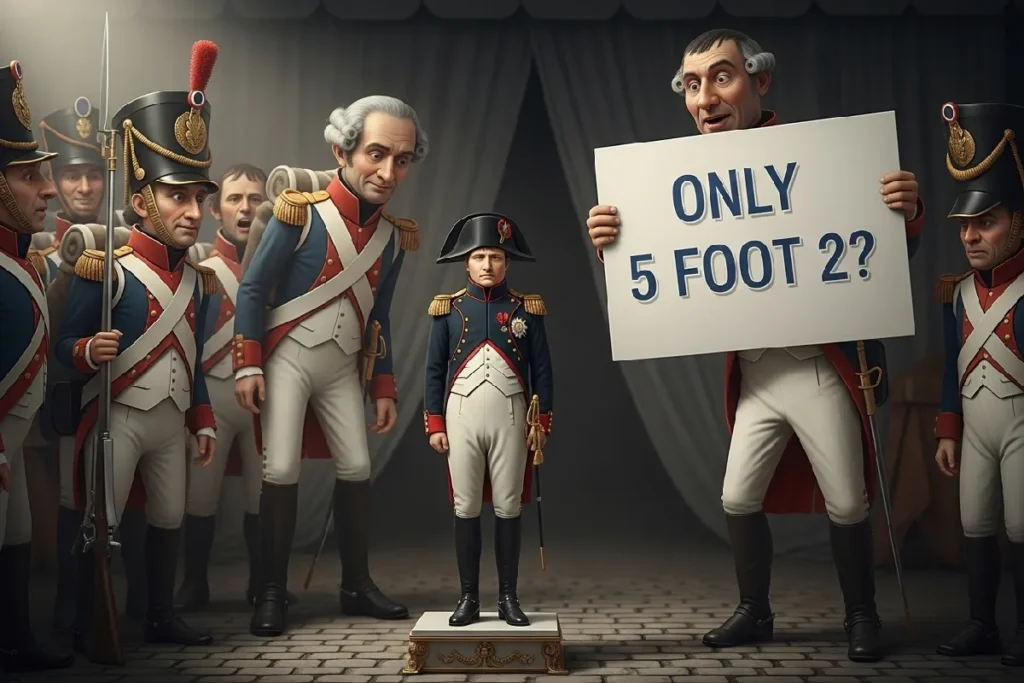
Conclusion
In retrospect, the construction of the Napoleon Height Myth was a masterclass in political narrative warfare. As we have seen, the myth did not originate from a single source but was built upon a foundation of convenient falsehoods and deliberate misinterpretations. It began with the simple, uncorrected error of confusing the French pouce with the British inch, a mistake that shaved critical inches off Napoleon’s actual, average stature. This factual-sounding error was then amplified by a relentless British propaganda machine, which used vicious caricatures to shrink the emperor in the public’s imagination visually and twisted his soldiers’ affectionate nickname, “Le Petit Caporal,” into a term of mockery.
The central truth, therefore, is that the story of Napoleon’s height was never about his physical body; it was a battle for his legacy. The myth was a calculated tool designed to diminish his formidable reputation, to make the conqueror of Europe seem small, petulant, and ultimately, less threatening. By transforming a respected military leader into “Little Boney,” his rivals successfully crafted a distorted image that has outlived the man himself by two centuries. The endurance of this fabrication is a testament to the power of propaganda to overwrite reality, proving that a well-told lie can be more permanent than a poorly defended truth.
Ultimately, untangling the Napoleon Height Myth offers a vital lesson for our own time. It compels us to be more critical consumers of information and to question the narratives presented to us, especially those concerning figures of power. This story is a powerful reminder that history is not just a collection of facts, but a series of arguments and interpretations, often shaped by those with a political agenda. The next time we encounter a universally accepted “fact,” we should pause and ask: who benefits from this story, and what truths might it be designed to hide?
